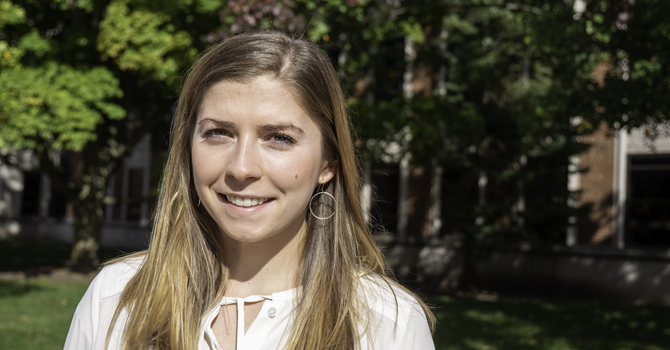Discovering Biostatistics and Its Broad Applications

Katherine Hoffman, MS ’18
Research Biostatistician, Weill Cornell Medicine
I cannot remember a time when I wasn’t interested in health care.
I grew up in Milan, Michigan, a small town south of Ann Arbor. My mother worked as a registered nurse and eventually became a nursing director. As a kid, I would carry around her stethoscope and sneak off with books on everything from medical malpractice and pharmaceutical scams to smallpox. In fifth grade, I read The Hot Zone and subsequently warned a number of people about the dangers of Ebola.
Statistics is a great discipline to study because there is an application for it in every other field.
I was considering medical school as an undergraduate and studied biochemistry while taking extra mathematics courses. Because I was drawn to medicine and health care from an early age, biostatistics was a natural fit for me. When I realized how biostatistics allows you to engage in any other field within public health and medicine, I decided to pursue it in graduate school.
The organizational skills I learned as a student-athlete are very useful to me now as a biostatistician juggling multiple projects and relationships with a variety of researchers.
During school, I did not appreciate the value of soft skills in a technical field like biostatistics.
I played softball as an undergraduate at the University of Detroit Mercy. Varsity athletics kept me extremely busy—practice 4 hours a day 6-7 days a week and playing 56 games a year. It felt like I was never in class. I balanced softball and academics by staying in constant communication with coaches, professors, and teammates and relying on friends to send notes from classes I missed. The organizational skills I learned as a student-athlete are very useful to me now as a biostatistician at Weill Cornell Medicine, where I juggle multiple projects and relationships with researchers from a variety of backgrounds.
Graduate life at Michigan helped me hone soft and hard skills.
Outside the classroom, I was engaged with STATCOM, a student organization that provides free statistics consulting and analysis to nonprofit and government agencies. STATCOM gave us an opportunity to get hands-on experience as biostatisticians, honing our communication skills with actual clients while refining all the technical skills we were learning in class. One of my projects focused on predicting trends in crisis call center volumes for a youth hotline in Ann Arbor. It was a great way to give back to the community while practicing my programming skills and statistical methods.
The arts and the sciences are closely related and valuable in all fields.
I love art, am fascinated with how people think, and wrote an undergraduate thesis on artistic portrayals of mental health. I wanted to spend time thinking and writing about how people deal with—and struggle to deal with—mental illnesses, especially depression. I focused on Vincent van Gogh and Sylvia Plath and how they portrayed their feelings of marginalization through art and writing. Even though the topic is less quantitative than statistics or biology, the critical thinking and writing skills I gained from this experience help me better express my ideas as a biostatistician.
I hope to help others discover biostatistics as a vital and exciting health field.
I enjoy the application of statistics so much that I started a blog called KHstats. As an undergraduate student, it was easy to picture my life as a physician or other provider of health care. It was more difficult to understand what my career would look like outside of direct patient care. I found it challenging to find information on what a biostatistician does on a daily basis in their career, so the blog’s primary goal is to share those granular details. Before I started graduate school, I assumed I’d study biology and statistics in equal measure, but it was actually about 99% statistics. So clearly, I could have benefited from my own blog a few years ago!
People have different skills to offer the many fields of medicine and health. Awareness of lesser-known opportunities in health care—including ones like biostatistics that often need a technical translation—is something I love to share. I’m really grateful to have found a discipline that suits my passions and skills.
- Learn more about biostatistics at Michigan Public Health.
- Learn more about how Big Data is being used in public health.
- Support research at Michigan Public Health.
